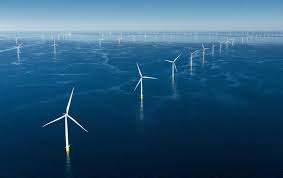Updated September 21, 2025: South Korea’s 8.2GW Shinan offshore wind facility is still under development, with early schemes already underway to serve as a precursor to the greater undertaking such as the Jeollanam wind project. The project is expected to be the globe’s biggest offshore wind complex. While there remain hurdles, not least in obtaining the correct legislation to further simplify the development process, there has been advancement, with recent contracts for supply parts awarded and ongoing efforts to develop a robust grid plan to support the sheer renewable power. The monumental project will benefit from the world’s largest offshore wind turbine developed by China’s Dongfast Electric.
March 18, 2021: The President of South Korea, Moon Jae-in has led his government in signing the contracts for the World’s largest offshore wind farm to be built in South Korea that is estimated to cost US$43.2 billion and will generate electricity to the capacity of 8.2 GW. This news comes after the president initiated his administration’s Green New Deal in 2020. a plan that is designed to advance the country toward carbon neutrality by 2050. Once fully linked to the grid, the offshore wind farm will produce as much energy as six nuclear reactors. Its size will dwarf that of the UK’s Hornsea 1 installation – the world’s largest offshore wind farm today, boasting 1.12 GW of generation capacity.
Also Read: South Korea inches closer to floating nuclear power plants.
Project Factsheet
Significance:
- Expected to be the world’s largest offshore wind complex with 8.2GW capacity.
- Will generate as much electricity as six nuclear reactors once linked to the grid.
- Central to South Korea’s Green New Deal and 2050 carbon neutrality target.
Infrastructure:
- Located off the coast of Shinan County, Jeollanam-do Province.
- Early schemes such as the Jeollanam wind project serve as precursors.
- Will feature the world’s largest offshore wind turbine, developed by Dongfang Electric.
Developer/Consortium:
- Backed by South Korea’s government under President Moon Jae-in (signed March 18, 2021).
- Key firms include Hanwha E&C, KEPCO, CS Wind, SK E&S, Doosan Heavy Industries, and Samkang M&T.
- Around 98% of financing is private-sector led, with the government contributing the rest.
Funding/Timeline:
- Estimated investment of US$43.2 billion.
- Contracts for supply parts have already been awarded as of September 2025.
- Project remains under phased development, with grid integration planning underway.
Challenges:
- Requires legislative reforms to simplify and accelerate permitting.
- Grid capacity expansion is essential to absorb large-scale renewable output.
The Blue House, South Korea (the president’s official residence) said the offshore World’s Largest Offshore Wind Farm in South Korea would provide as many as 5,600 jobs and help the country meet its target of 16.5 GW of wind power capacity by 2030. Currently, it’s at 1.67 GW. As it stands, liquefied natural gas and coal imports play a major role in its energy mix. In 2020, 40% of its electricity came from coal-fired power plants, followed by gas-fired units providing around 26%. Nuclear energy supplies around 25% and renewables account for most of the remainder. There are 24 nuclear power plants in the country, with most of them located at two complexes in its densely populated southeastern region – near Busan, Gyeongju, and Ulsan, which are home to several heavy manufacturing plants.
According to the Norway-based energy research group Rystad Energy, global offshore wind power capacity is set to increase by 37% this year. Although mostly from new installations in China. Companies that will be involved in the construction include Hanwha Engineering & Construction Corp, Korea Electric Power Corp. (KEPCO), CS Wind Corp, SK E&S, Doosan Heavy Industries & Construction Co., and Samkang M&T Co. These and any other companies involved will provide around 98% of the financing, with the government providing the rest.

